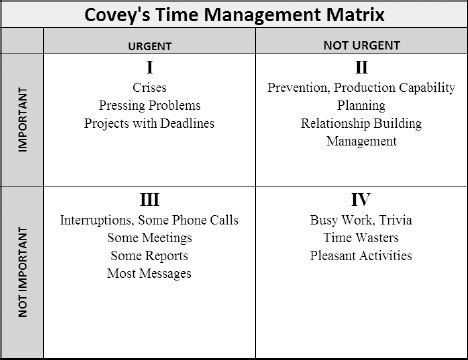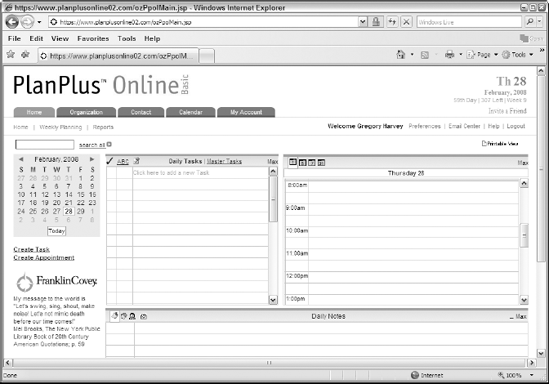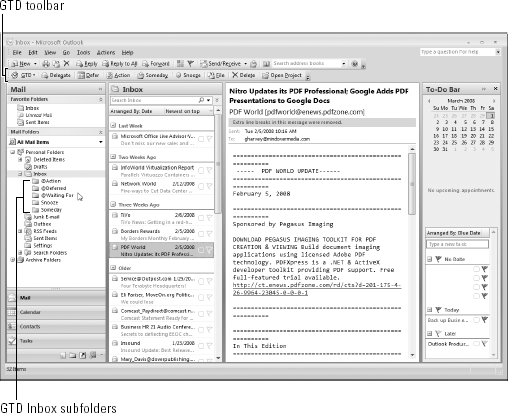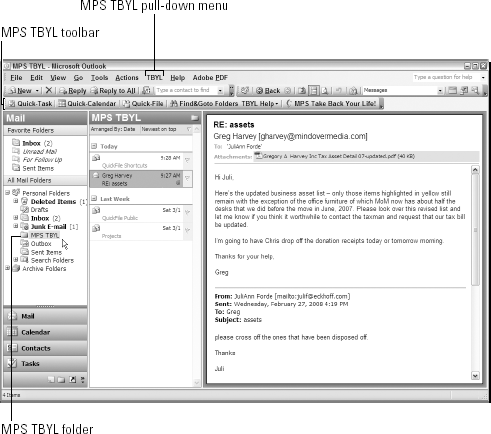This chapter acquaints you with four time management/personal productivity systems whose principles have been especially adapted for Microsoft Outlook users. By taking a cursory look at these systems, you can get a good idea of how broader productivity principles (such as those covered in Chapter 2) are specifically applied to Outlook.
The first system you explore is the one promoted by FranklinCovey, a company perhaps best known for its popular paper calendars and day planners. This company is also famous for coaching all levels of business people on how to become more productive using time management techniques that rely heavily on effective planning.
The second system you examine is the one espoused by productivity maven, David Allen, a highly successful and renowned professional productivity motivator and trainer. Allen's system centers around a five-stage workflow model designed to enable you to prioritize your tasks and act accordingly.
The third system you survey is the one created by corporate productivity trainer, Sally McGhee. McGhee's system is composed of three stages that create what she calls an integrated management system — a system designed to lead you to flawless planning and task execution.
The fourth (and final) system you take look at in this chapter is the one championed by "efficiency guru" Michael Linenberger. Linenberger's system for taking control of your workflow concentrates almost exclusively on techniques that promote efficient task and e-mail management.
FranklinCovey is a trusted provider of time management and personal productivity advice. Founded by the merging of Hyrum Smith's Franklin Quest (distributor of the famed Franklin Day Planner) with Stephen R. Covey's Covey Leadership Center in May, 1997, FranklinCovey offers a wide variety of management and assessment tools, training, and personal coaching for businesses of all sizes.
Tip
For a complete list of the various types of products and training available from FranklinCovey, visit its Web site at www.franklincovey.com.
In 1989, Stephen Covey published his bestselling self-help book entitled, The 7 Habits of Highly Effective People: Restoring the Character Ethic (Tandem Library). This blockbuster explains the seven traits that Covey considers to be the fundamental characteristics of highly successful people, professionally as well as personally.
According to Stephen Covey, decidedly effective people routinely practice the following seven principles:
Act Proactive: They take time to formulate their responses to situations they find themselves in rather than simply making knee-jerk reactions to them.
Begin with the End in Mind: They visualize the desired results and then take the steps necessary to achieve them.
Put First Things First: As the masters of time management and organization, they successfully prioritize their tasks to reach their goals.
Think Win/Win: They seek accords and results that are mutually satisfying to everyone involved rather than simply seeking to triumph at any cost.
Seek First to Understand, and Then Be Understood: They practice "empathic listening" whereby they listen to others with the intention of understanding what others are saying, rather than preparing a reply to it.
Synergize: They practice creative cooperation whereby they remain open to new possibilities, alternatives, and options.
Sharpen the Saw: They practice principles of balanced self-renewal that enable them to reenergize themselves physically, mentally, socially, and spiritually.
As you might deduce from Covey's list of the seven habits of highly effective people, his system of time management is very big on planning. In fact, it plays such an important role in his systems that it's probably not an exaggeration to say that, in his estimation, successful time management is a direct byproduct of successful planning.
As the first three principles in his list of habits indicate, this planning can come in the form of responding appropriately to situations at hand, effectively visualizing the outcomes or goals you want to achieve, as well as properly prioritizing tasks that are before you.
Effective planning is then buffered by the other four principles that enable folks to behave ethically and benevolently in their business dealings, practice excellent communication skills, cooperate well, and regularly renew and revitalize themselves.
Note
Keep in mind that, according to FranklinCovey, those who excel at time management are not only are wizzes at setting their priorities but are the ones who use planning tools effectively. They use these planning tools to set goals, to work on those goals, and to relate their professional and personal values and roles to their priorities. In large part, this explains why the company offers such a wide array of paper and electronic scheduling products in addition to training materials and services.
In his chapter on organizing your priorities ("Habit 3: Put First Things First: Principles of Personal Management") in The 7 Habits of Highly Effective People: Restoring the Character Ethic, Covey introduces his Time Management Matrix (shown in Figure 3-1). You can use this table to analyze your activities and put them into one of four quadrants:
Quadrant I, Urgent-Important (also known as the Necessity Quadrant): Activities in this quadrant include problems and projects that must be dealt with on the spot.
Quadrant II, Not Urgent-Important (also known as the Productivity Quadrant): Activities in this quadrant enable you to plan effectively.
Quadrant III, Urgent-Not Important (also known as the Deception Quadrant): Activities in this quadrant present themselves as critical but actually need to be planned effectively.
Quadrant IV, Not Urgent-Not Important (also known as the Waste and Excess Quadrant): The activities in this quadrant aren't really critical but do pass the time.
Tip
The purpose of Covey's Time Management Matrix is not just to identify the quadrant into which your professional and personal activities fall. It's more essential purpose is to encourage you to find ways to spend more of your time doing Quadrant II activities and much less time doing Quadrant III stuff. In fact, the mark of a truly productive person is one who knows how to invest more time in Quadrant II at the expense of time squandered in Quadrant III.
When you understand how important planning tools are to the FranklinCovey system of time management, you won't be surprised to find out that the company now offers software solutions in addition to its long line of paper day planners and other forms.
FranklinCovey currently offers three versions of PlanPlus, its electronic planning software program: PlanPlus for Outlook, PlanPlus for Windows, and PlanPlus Online (each discussed in the following sections).
PlanPlus for Outlook is really convenient because, as an add-in program, it runs right within Outlook, enabling you to use all of its special features along with all of Outlook's regular features. In Outlook, this add-in program inserts its own pull-down menu and toolbar, and appends specialized folders to the Navigation Pane.
Figure 3-2 shows you the Outlook program window when you click the FranklinCovey folder in the Navigation Pane. Doing so displays the FranklinCovey version of the Outlook Today view in the program's Information Viewer.

Figure 3-2. PlanPlus for Outlook as it appears in Outlook 2003 when you select the FranklinCovey folder.
As you can see in this figure, the FranklinCovey version of Outlook Today is very similar to the regular Outlook Today display (with its Calendar, Tasks, and Messages areas).
In addition to these common areas, PlanPlus adds a Compass and a Weekly Jump Starter area (shown in Figure 3-2). The Compass area is where you can add the physical, social, and spiritual activities that help renew you (listed under the heading, Sharpen the Saw) as well as your major (weekly) goals (referred to as "big rocks") for the various roles that you play (manager, spouse, parent, friend, mentor, and so on). The Weekly Jump Starter contains inspirational quotes and other time management information designed to keep you motivated.
Figure 3-3 shows how the PlanPlus add-in program appears in Outlook when you select the Home folder that appears immediately below the FranklinCovey folder in the Navigation Pane. (Note that you can also select this folder by clicking the PlanPlus Home item on the PlanPlus pull-down menu or the PlanPlus Home button on the PlanPlus toolbar.)
When you select the Home folder, the Outlook 2003 Information Viewer displays the PlanPlus Home, including its own menu buttons, display panels, and e-mail toolbar.
PlanPlus Home gives you immediate access to your monthly calendar, task list, daily schedule, and the e-mail messages in your Outlook (although only the first one or two of the most recent messages can be displayed in the e-mail panel at its default size).
Tip
To enlarge the e-mail display panel in the PlanPlus Home so you can read more than just the first message in your Inbox, click the Maximize button — the button on the far right of the e-mail toolbar. (Refer to Figure 3-3.) Then, after reading and dealing with your messages, you can return the e-mail panel to its original size by clicking the Restore button. (This button automatically replaces the Maximize button on the e-mail toolbar.) Note that in its maximized incarnation, the e-mail toolbar appears immediately beneath the menu buttons — Home, Project, Weekly Planning, and Coach Me — at the very top of the Information Viewer.
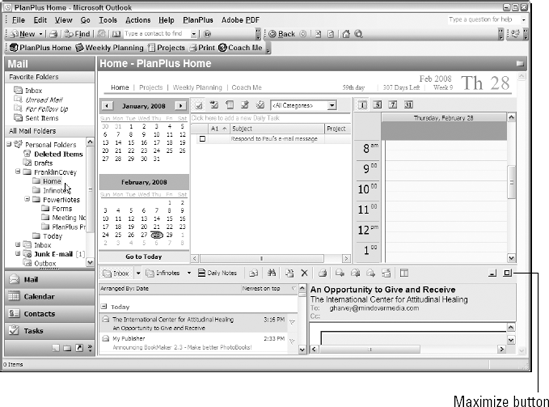
Figure 3-3. The PlanPlus Home as it appears in the Outlook 2003 Information Viewer when you select the Home folder.
PlanPlus for Windows runs as a separate program under Windows XP or Tablet PC edition or Windows Vista. Figure 3-4 shows the PlanPlus for Windows program window as it appears when you first launch the program. (To launch it, double-click its program icon on the Windows desktop or click the Windows Start button and then choose Start
As you can see in this figure, as a full-fledged application, PlanPlus for Windows has its own pull-down menus; system of toolbars (8 of the total 14 toolbars are automatically displayed); and tabs (Calendar through Notes).
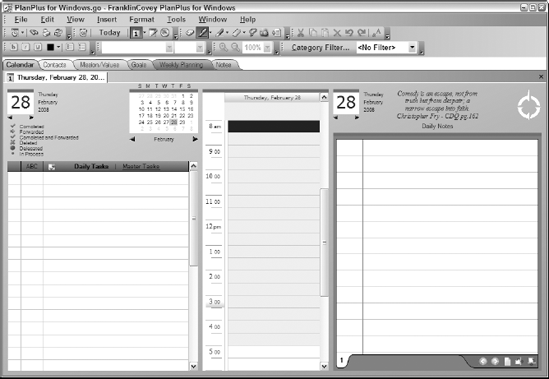
Figure 3-4. PlanPlus for Windows program window as it appears when you launch this standalone program.
Unlike PlanPlus for Outlook, whose Home gives you immediate access to different types of information (calendar, task list, and e-mail) in a single view, PlanPlus for Windows employs a system of tabs that, when clicked, give you access to its various management tools (Calendar, Contacts, Mission/Values, Goals, Weekly Planning, and Notes). In this way, PlanPlus for Windows is more like standard Microsoft Outlook, where you can display each of information modules (Mail, Calendar, Contacts, Tasks, Notes, and Journal) by clicking its button in the Navigation Pane, by selecting its menu item from the Go pull-down menu, or by pressing its shortcut keystroke.
Warning
The biggest drawback to using PlanPlus for Windows is that its e-mail functions include only the most rudimentary of features. This means that you will almost definitely still have to use a separate e-mail program such as Outlook Express (when running under Windows XP) or Windows Mail (when running under Vista) to deal with e-mail messages. If you feel as though having to understand and deal with more than one program to manage all your personal information including e-mail may be too much for you, stick with PlanPlus for Outlook or PlanPlus Online if you're tempted at all to adopt the FranklinCovey planning system in some sort of electronic form.
PlanPlus Online
In addition to PlanPlus for Outlook and Windows, FranklinCovey also offers PlanPlus Online. This newest version of the ever-popular PlanPlus program runs in whatever Web browser you use on your personal computer, laptop, PDA, or smart phone.
This means with PlanPlus Online, you can check appointments you keep in your PlanPlus calendar along with the tasks entered in your to-do list from almost any device that can run a Web browser and has Internet access. This ability to check your personal information from any Internet-enabled computer is a real boon to anyone who travels extensively and uses a lot of different types of portable devices (including PDAs, cell phones, and laptop computers) while on the road.
Note
Keep in mind that when you purchase PlanPlus Online, rather than purchasing a software license to a program on a disc or for download, as with PlanPlus for Outlook and PlanPlus for Windows, you're purchasing a monthly subscription service that you can access from any Internet enabled-device. Paying a monthly subscription can make using PlanPlus Online significantly costlier than PlanPlus for Outlook or Windows, when viewed over the long term.
Figure 3-5 shows you the PlanPlus Online initial display screen that appears when you access your account using Microsoft's Web browser, Internet Explorer 7. As you can see in this figure, PlanPlus Online combines Calendar, Tasks, and Note functions in its Home screen (somewhat similar to PlanPlus for Outlook) and also contains a series of tabs (like PlanPlus for Windows) along with a row of buttons immediately below the tabs that enable you to access the different modules included as part of the online program.
David Allen is a well respected productivity guru in the corporate world. Hailed by Fast Company magazine as "one of the world's most influential thinkers on productivity," Allen is the author of a couple of very insightful — not to mention bestselling — books on personal productivity: Getting Things Done: The Art of Stress-Free Productivity and Ready For Anything: 52 Productivity Principles for Work and Life (both published by Penguin).
Like other experts in the personal productivity field, Allen hasn't stopped at writing self-help books. He also conducts corporate training and seminars. And his company now offers his celebrated productivity system in an electronic form for Outlook called the Getting Things Done (GTD) Outlook Add-In.
For more background information on David Allen as well as to purchase his books or other products, check out his Web site at www.davidco.com.
David Allen's productivity system, frequently called Getting Things Done after his bestselling title by the same name, is centered on the concept of stress-free productivity. In other words, Allen finds little use for becoming more efficient at work or at home if this efficiency comes at the price of increased stress. (In fact, his emphasis on stress-free productivity may be one of the main reasons why he's so well-liked and his ideas are so widely respected in the business world.)
At its most basic, Allen's Getting Things Done productivity system consists of the following five stages:
Collect: This stage involves using your own preferred tools to accumulate all of the stuff in your professional and personal lives that you consider incomplete or requiring some sort of change.
Process: This stage involves determining the relative importance of all the stuff you identify as incomplete and deciding what steps are required to make them complete.
Organize: This stage involves deciding where to store all the stuff that you determine still needs completing.
Review: This stage involves routinely reviewing (Allen usually recommends on a weekly basis) all the stuff that you still identify as incomplete.
Do: This stage involves deciding whether or not the stuff you see as incomplete is worth taking up now or at some later time.
As you can see from this list of five stages, Allen sees productivity as fundamentally stemming from a set of planning stages (Collect, Process, Organize, and Review) that are used to help you determine the priority of all incomplete items (Do).
One of the more radical aspects of Allen's Getting Things Done productivity system is its rejection of the traditional to-do list. According to Allen, traditional to-do lists don't work for two reasons:
A typical workday's fresh input and continuously changing priorities habitually render the items you put on your to-do list impossible to get to and complete.
Anything you put on a to-do list that you don't absolutely have to do on that day reduces the importance of the things you've put on that you really do have to get done.
In place of generating do-do lists, Allen's system calls for placing all reminders of the actions you still need to do either on a calendar (as time-specific appointments, day-specific actions, or day-specific information) or into what he calls Next Actions lists.
Next Actions lists answer the crucial processing questions for every project you undertake. (According to Allen, a project is a task that you can't complete with a single action.) Each item you place on a Next Actions list describes a single consecutive action or step that you must complete in the series in order to move along and ultimately finish the project. The most important thing about a Next Action step is that it describes a very specific physical activity that you'll undertake. (Mental planning activities or vague actions like "set up a meeting" don't count.)
After you decide on a Next Action step, you then have three options for handling it:
Do It: You perform the action if you estimate that you can complete it within two minutes or less (Allen's two-minute rule).
Delegate It: You send it to someone else on the team if you determine that you're not the best person to undertake the action.
Defer It: You place it in a Someday or Snooze file if you determine that you need more information to do it or it will take longer than a couple of minutes.
If you find that there's no Next Action step associated with a particular item you come up with for your list, Allen then suggests that you place the item into one of three physical or electronic containers: the trash, a Someday file, or a reference file.
In addition to his bestselling books and ever-popular seminars, David Allen also markets an Outlook add-in program that enables you to better follow his productivity principles when using Outlook as your personal information manager. Developed and supported by an outfit named NetCentrics, this auxiliary program adds Getting Things Done capability to Outlook in the form of a GTD toolbar and several ready-made subfolders in your Outlook Mail Inbox.
Figure 3-6 shows you Outlook 2007 running the Getting Things Done Outlook Add-In. (This add-in program looks the same when running in Outlook 2003.) As you can see in this figure, a GTD toolbar with buttons GTD through Open Project appears directly beneath the Standard toolbar. In addition, you can see that the add-in has created a bunch of subfolders — @Action through Someday — within the Outlook Mail Inbox folder.
Personally, I find the Manage Projects features of the Getting Things Done add-in most useful. You can use these features to quickly record the next actions you've identified in order to complete a particular project as well to track your progress.
In addition, the Inbox subfolders created by the Getting Things Done add-in make it a great deal easier to manage your e-mail. As messages come into your Inbox, you quickly process them by simply dragging and dropping them into the appropriate GTD subfolder. Of course, if you drop messages into the Action subfolder, all you have to do is open this subfolder in order to respond to them (assuming that you've determined that you can answer each one in two minutes or less).
Sally McGhee is another highly recognized expert in the personal productivity field, having now more than 25 years of experience coaching and training business executives on how to be more productive and achieve better work/life balance. She is the founder and managing partner of McGhee Productivity Solutions (MPS for short) as well as the author of the Microsoft Press book, Take Back Your Life!: Using Microsoft Outlook to Get Organized and Stay Organized.
To get more information on the MPS approach to personal productivity, the company's consulting and training services, as well as Sally McGhee's Take Back Your Life! title, visit her Web site at www.mcgheeproductivity.com.
Sally McGhee's philosophy on personal productivity is summed up simply in her very astute quote, "Productivity is not about getting more things done. It's about getting the right things done."
This emphasis on recognizing the "right" things to do before you undertake them is evident in the stages she singles out in her McGhee Productivity Solutions (MPS):
Identifying Meaningful Objectives: In this stage, you prioritize things you need to get done and determine how getting them done helps you meet your work and life goals. After spelling out your objectives in this way, you then create a supporting project for each objective that identifies the resources you need in order to meet it.
Creating Strategic Next Actions: In this stage, you identify and list the sequence of all the actions that you need to take in order to complete the projects and meet the objectives you've set. These next actions count as strategic only if they don't require any additional steps before you undertake them (or are "without dependencies" in the parlance of Sally McGhee).
Scheduling and Completing Strategic Next Actions: In this stage, you schedule all the strategic next actions you've identified by putting them on your calendar.
Reviewing and Course Correcting: In this stage, you track your progress on completing the strategic next actions you've identified, evaluate how close you are to realizing your objectives, and make any changes called for by shifting conditions.
For McGhee, the key to being successful with the McGhee Productivity Solutions cycle involves you creating what she calls the Integrated Management System, or IMS for short. (Is it just me, or are all this jargon and acronyms getting to be a bit too much?)
The McGhee Integrated Management System is composed of the following three systems:
Collecting System: This system consists of the physical locations you use to record your actions and where you and other co-workers place tasks and information relevant to your projects. These locations include e-mail, voice mail, and a paper inbox.
Reference System: This system consists of the locations where you store all the information needed in order to complete a project as well as any other pertinent information that doesn't require action on your part but to which you may later need to refer. These locations include your address book, Outlook notes, folders you add to the Outlook Folder List, and any other folders on your system or on the Internet in which supporting documents are stored.
Action System: This system consists of your meaningful objectives, supporting projects, and Strategic Next Actions. These are normally stored in your Outlook Task List or To-Do List as well as on your Outlook calendar.
To help you implement her productivity system using Outlook, Sally McGhee offers an add-in called the MPS Take Back Your Life! 4Outlook. Developed in collaboration with a company named Standss (South Pacific) Limited, this auxiliary program adds McGhee Productivity Solutions capability to Outlook in the form of a MPS Tack Back Your Life toolbar, a TBYL pull-down menu, and a TBYL folder in the Folders List in the Navigation Pane.
Figure 3-7 shows you Outlook 2003 running the MPS Take Back Your Life! 4Outlook Add-In. (Note that this add-in doesn't appear significantly different when running in Outlook 2007.) When you run this add-in, the MPS Take Back Your Life toolbar appears immediately below the other Outlook toolbars you have open. In addition, this auxiliary program adds its own TBYL folder to your folder list in the Navigation Pane.
Among my favorite features offered by this add-in are the Quick buttons on its MPS Take Back Your Life toolbar. The Quick buttons enable you to quickly process e-mail messages you receive in one of the following three ways:
Quick Task: Click this button to create a new task from any e-mail message you receive.
Quick Calendar: Click this button to create a new appointment on your Outlook calendar from any e-mail message you receive.
Quick File: Click this button to file a copy of any e-mail message you receive in any of the reference folders you maintain.
Last but not least is "efficiency guru" Michael Linenberger, the author of Seize the Workday: Using the Tablet PC to Take Total Control of Your Work and Meeting Day and Total Workday Control Using Microsoft Outlook, 2nd Edition, which was hailed as the number-one bestselling Outlook book on Amazon. com, no less (both books from New Academy Publishers).
Like the other productivity experts highlighted in this chapter, in addition to his books, Linenberger offers a variety of productivity services including training and seminars. For more information on Michael Linenberger and the services his company offers, visit his Web site at www.workdaycontrol.com.
In place of a complete productivity system on the order of David Allen's or Sally McGhee's, Michael Linenberger's bestselling Total Workday Control Outlook book boils successful productivity down to eight simple task and e-mail practices in Microsoft Outlook. These practices can be summarized as follows:
Track all your tasks in the Outlook Task List (2003) or To-Do List (2007).
Maintain a master task list that's distinct from your daily task lists.
Adopt a simple system for prioritizing tasks that stresses the tasks you must get done.
In your daily task lists, record only Very Next Actions (think Allen's Next Action and McGhee's Strategic Next Action here) that you need to undertake.
Keep your tasks lists up-to-date by performing both daily and weekly planning (similar to doing reviews in both Allen's and McGhee's system).
Whenever possible, convert your e-mail messages to tasks.
File your e-mail messages into Outlook categories.
Effectively delegate the tasks that you're not the best qualified to undertake.
I don't know about you, but I get a certain déjà-vu all-over-again feeling just reading Linenberger's list of best practices. Somehow it seems to contain a hint of David Allen's thinking with a wee bit of Sally McGhee's values thrown in for good measure. Of course, this may be a case of great (productive) minds thinking alike, or maybe it's simply the case that there are only so many ways to emphasize the importance of maintaining to-do lists filled with premeditated next actions?
As you'd expect from any efficiency guru worth his or her salt, Michael Linenberger promotes an Outlook add-in program designed to make it easier for you to implement his best task and e-mail management practices. Called the Information Management System (IMS) for Outlook, this add-in was developed by a company named ClearContext which markets it in partnership with Linenberger's Total Workday Control.
Figure 3-8 shows you Outlook 2007 running the IMS add-in. (Note that this add-in doesn't appear significantly different when running in Outlook 2003.) When you run this add-in, the ClearContext toolbar appears immediately below the other Outlook toolbars you have open. In addition, this auxiliary program adds its own ClearContext pull-down menu and ClearContext Deferred, IMS, and Unsubscribed subfolders to the Inbox folder list in the Navigation Pane.
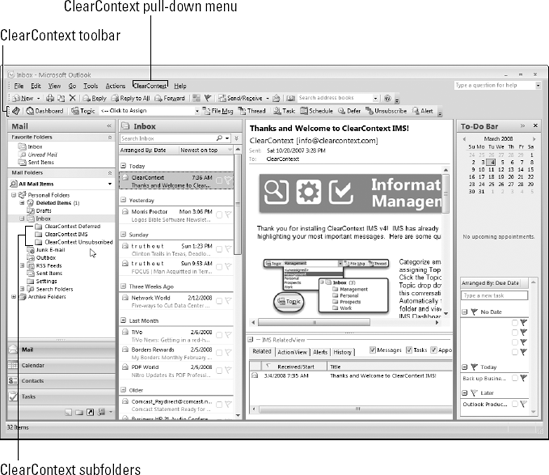
Figure 3-8. Outlook 2007 running the IMS add-in with its Clear-Context toolbar, menu, and subfolders.
After installing the IMS add-in, the program automatically analyzes the e-mail messages you've stored in Outlook to determine which are the most important messages and flags them accordingly. You can then also use its commands to flag a particular message or to modify the priority of a particular contact or to quickly file messages in a particular Inbox folder as well as quickly convert messages to tasks on your Task List or appointments on your Calendar.
In my opinion, one of the niftiest features of the IMS add-in program is its Dashboard view. You can display this view in three ways: by clicking the Dashboard button on the ClearContext toolbar, by clicking the ClearContext IMS folder icon in the Folder list of the Navigation Pane, or by selecting the Dashboard item on the ClearContext pull-down menu.
The IMS Dashboard uses the Outlook Information Viewer to display in a single view various panels listing your currently flagged messages, appointments, and tasks. In addition, the IMS Dashboard contains a Status panel that shows you at a glance the number of flagged messages and appointments you have, along with the number of tasks labeled Overdue, Due Today, and Due Sometime in the Current Week. Having all this information at your fingertips in the IMS Dashboard view can be really helpful in preparing for and planning your workday.

